A study published in the Journal of Strength and Conditioning found that after 6 weeks, plyometric exercises were more effective in improving the running economy in runners than weight-lifting. These 8 plyometric exercises for runners will make you stronger so you can run faster.
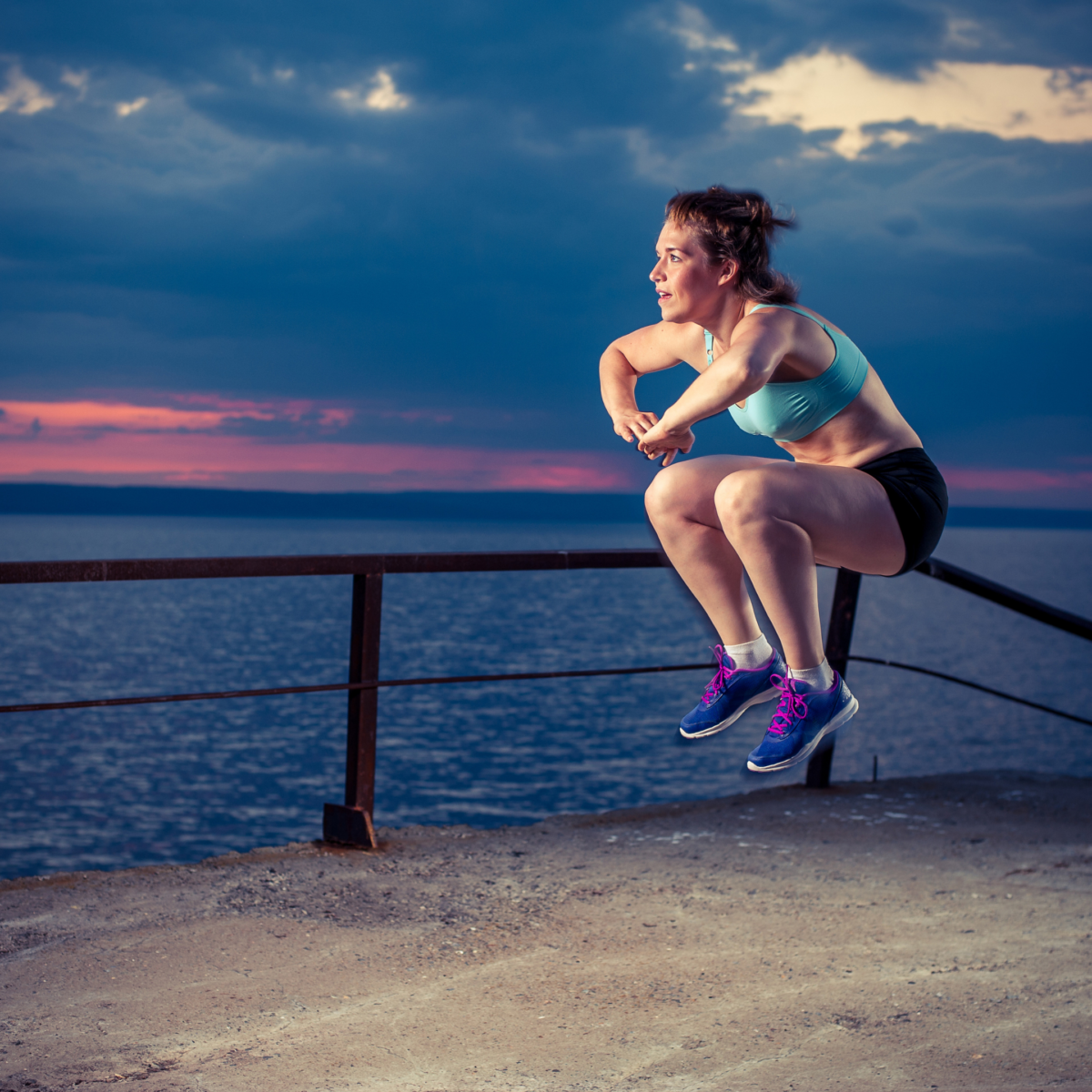
I started incorporating plyometric exercises for speed into my training when recovering from my hamstring injury.
Plyometrics workouts work wonders for your neuromuscular fitness which I needed. My injured leg was lagging behind my other and regular plyometrics workouts helped regain its power–regulating my stride and increasing my turnover.
In essence, the plyometric training retaught my muscles how to work together efficiently again. Plyometric exercises also strengthened the tendon and muscle tissue which had been degrading following a tear.
When I returned to the track after more than a year off, I must say—it was magical. My left leg and right leg both felt stronger and worked together almost effortlessly.

Plyometric Workout Tips
In the growing list of the little things that help you become a better, faster runner, less is more with a plyometrics workout (which is essentially jump training) as it is hard on the body.
When doing plyometrics moves:
- focus on proper form over intensity,
- quality over quantity,
- and fully recover in between sets
Also, what’s great about this plyometrics workout for runners is it can be done at home and your kids (those bouncy little things) can do the plyometrics drills with you!
By incorporating just a little bit into your strength training, your body will naturally become more efficient. And, I am here to teach you how to do it.
Table of contents
How do plyometrics increase speed
Plyometric drills help increase speed because they make runners’ strides more powerful and efficient.
When your foot strikes the ground, it is exerting force. The more force you have hitting the ground, the further you are going to propel forward and the less time it will take to apply it again and again.
How do you increase force? By improving your brain and muscle communication aka promoting neuromuscular adaptations. This happens in a couple of ways:
- You increase the number of muscle fibers your body can activate simultaneously.
- You increase your motor unit firing rate.
Muscle fiber recruitment:
When you contract a muscle, you don’t use all of your muscle fibers. That would break your bone. Instead, the average person uses about half of their muscle fibers, notes Brad Hudson in Run Faster.
Plyometric exercises teach the brain to activate more muscle fibers at once and to get used to doing this. Muscle fibers use oxygen, and thus the more oxygen you use, the more you will tire. So, they need to become stronger (more force using less energy) to improve running economy.
Motor firing rate:
Plyometrics can also increase the motor unit firing rate—the time it takes for your brain to generate a command to the muscle to contract and the time it takes the contraction to begin, notes Hudson. This shortened time span allows muscles to apply the force more quickly.
Related: 9 Running Hacks to Make You Run Faster
Will plyometrics make me faster?

Yes. Studies show that plyometric exercises can make you run faster.
A study published in the Journal of Strength and Conditioning comparing a strength training routine to a plyometric routine in runners found that, after just 6 weeks, plyometric exercises were more effective in improving the running economy in runners than weight lifting.
Another study also found improved running economy after runners did plyometrics, and others find a link between plyometrics and improved 10k and 5k times.
Thus, there are many reasons plyometrics are good for runners.
If you are like many mother runners, you may be thinking–but this will leave me with wet shorts! Check out my Practical Guide to Stop Leaking.
8 reasons plyometrics are good for runners
Plyometrics for runners:
- teach the body to use more of the muscle fibers it has in its arsenal for explosive power;
- make these muscle fibers stronger;
- help these muscles use less oxygen/energy when they fire;
- and increase the rate at which these muscles turn on. They also
- put stress on the bones and soft tissue, strengthening them and preventing running injuries, notes Jeff Parke of Top Fitness Magazine. And, they
- improve the cardiovascular strength and endurance capacity of the body (VO2 max and running economy), adds Andrew Fox, CEO of Aim Workout.
- Plyometrics for runners also turn tendons into springs allowing the runner’s small amount of stored energy in the muscles to last longer, which is key in longer-duration running events, says certified kinesiologist Jake Harcoff, head coach and owner of AIM Athletic.
How to incorporate plyometrics into your running schedule
Just like with running, it is important to ease into a plyometric workout to avoid injury. The frequency of these plyometric movements will depend on where you are in your run training and your fitness level.
You can do a plyometric-only workout as part of your strength training. Aim to do this just once every 3 weeks, advises Dr. Jerome Enad, an orthopedic surgeon, due to the stress to the muscles. Or, you can sprinkle in the below moves into your regular strength training routine, doing a couple each week and mixing them up.
When to do plyometrics
The timing of your plyometric exercises depends on what sort of running and training you are doing.
- Do not do a plyometric workout before a hard or long run day.
- Do not do a plyometric workout right after a hard workout or long run day.
- It is best to perform a plyometric workout after an easy run or several hours after a hard run effort, says Dr. Jerome Enad, an orthopedic surgeon.
Get more dos and don’ts of strength training for runners.
How many times a week should you do plyometrics exercises
You can sprinkle plyometrics into your regular strength workout routine—whether that be two or three times a week. Beginners should aim to one plyometric training session a week since it is hard on the body in both impact and cardiovascularly. You’ll find that plyometric workouts get your heart pumping.
If you are doing a plyometric-only workout, aim to do this every third week to allow the body to recover.
The best at-home plyometric exercises for runners
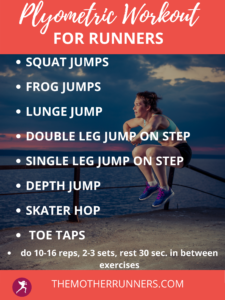
It is important to do plyometric exercises that mimic running. Power is movement specific-so improved power in one activity doesn’t translate to another. Different activities require different muscle coordination patterns.
These 8 plyometric exercises for runners mimic running to add more power to your stride and help you run faster. And, what’s great about these plyometric exercises is that this is an AT-HOME plyometric workout for runners. (View a demo of the plyometric workout here.)
The 8 BEST Plyometric Exercises for Runners
Here are the best plyometrics for runners:
- Jump squats or squat jumps
- Jumping lunge
- Frog jump
- Double leg jump on stairs
- Single leg jump on stairs
- Skater hop
- Toe taps
- Depth jump
Aim to do 10-16 reps of each of these full-body exercises. If you are doing a plyometric-only workout, do 2-3 sets, resting for 30 seconds in between. Be sure to use good form throughout to prevent hurting yourself!
Squat Jumps
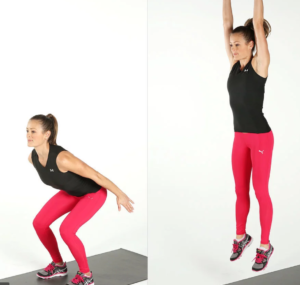
Jump squats or squat jumps are explosive movements that raise your heart rate, give you power, and help prevent injuries like runner’s knee or IT band syndrome, says Rohan Arora, a certified personal trainer.
How to do:
a) Stand with feet about hip-width apart, and lower your body in a usual squat position.
b) Immediately straighten your legs and propel your body into the air, jumping with both your feet.
c) Land back to your original position and quickly perform another squat.
d) TO increase the intensity, focus on jumping as high as possible, and go down as deep as your body allows during the squat position.
Jumping lunge
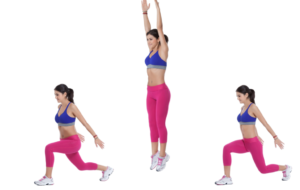
This exercise targets all the muscles that are needed while running, strengthening, and improving your performance over time.
How to do:
a) Start the exercise in a normal lunge position, equally distributing the weight on both legs.
b) Jump straight up into the air while reversing the position of the legs and landing with your feet in the opposite position. Lower down your body into a lunge and repeat the movement.
c) Alternate sides on each jump.
Frog Jumps
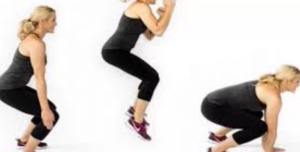
The frog jump move targets your glutes, hamstrings, and quadriceps, all of which are important muscles for runners, says Arora.
How to do:
a) Starting position: stand with feet about hip-width apart and bend down into a squat position.
b) From there, jump forward into the air like a frog, landing with both feet in front of where you started.
c) As soon as you land, immediately go back into the squat position.
Double Leg Jumps on Stairs
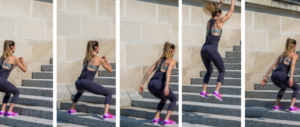
Another one that strengthens all muscle groups and gives your body power and increases the speed of communication between the brain and muscles. (This is more advanced. You can also do a pogo jump which is bounding straight into the air from a standing position or jump rope, aiming for 100 rotations).
How to do:
a) Begin by standing with feet about hip-width apart in front a stair step (or two, if advanced).
b) From there, jump forward, landing with both feet in front of the step.
c) As soon as you land, immediately jump back.
Single-Leg Jumps on Stairs
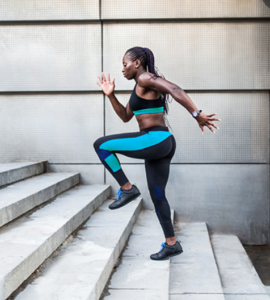
This plyometric exercise for runners is great for strengthening your chain of command. (This move can also be done on the ground as a single-leg hop. Mix it up and do up and down, side to side, and forward and back.)
How to do:
a) Begin by standing with feet about hip-width apart in front a stair step (or two, if advanced). Feel free to hold onto a wall for balance.
b) From there, jump forward landing on one foot. Immediately jump back.
Skater Hop
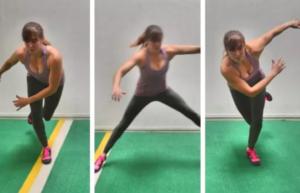
Skater hops target all the major muscles in your legs from quads to calves, helping you build balance between your dominant and non-dominant sides. Lateral jumps are important for runners in preventing injuries since we move in just one plane of motion.
How to do:
a) Begin by standing with feet about hip-width apart, bend your left knee to lower your hips a few inches while raising your right foot off the ground. b) From there, bound to your right and push off your left leg. (Picture what ice skaters do). c) Land softly on the right leg, allow your left leg to cross behind you and your arms to swing in the same direction. Repeat.
Toe taps
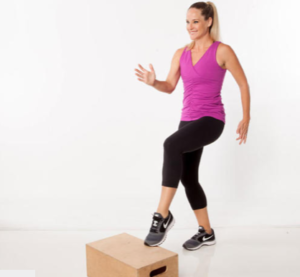
This is also known as fast feet and build activate muscles quickly, add power to your stride, and even out imbalances.
How to do:
a) Put on foot on a ball, step, or object. (You can also do this with hands on a wall, off the floor, with your body at a slight incline). b) Then quickly tap your toes like you are running in place and the step is hot. Be sure to drive your knees up.
Depth Jump
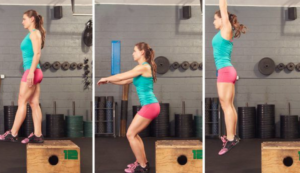
Depth jumps or box jumps exercise for runners trains the body to use the elastic energy from ground contact to produce greater concentric muscular force to propel you forward.
How to do:
a) From a standing position on a 1-foot-tall box or step, jump onto the ground and land in a squat position. b) From the squat position, jump as high as you can and landing softly on the ground. Focus on increasing your vertical jump height.
Other moves to add to your routine include burpees, step-ups, and star jumps.
How long should a plyometric workout last?
This plyometric workout should last 30 minutes.
Related: 8 Running Drills to Run Faster and Improve Running Form
These powerful movements along with aerobic conditioning, strength training, strides, hill sprints, and drills are the ingredients you need to run faster, reduce risk of injury, and be the best runner you can be!
If you want guidance with your running goals, including during perimenopause or menopause, check out my run coaching services. Also, be sure to check out my free training plans:

Very interesting and seems convincing. Thank you very much